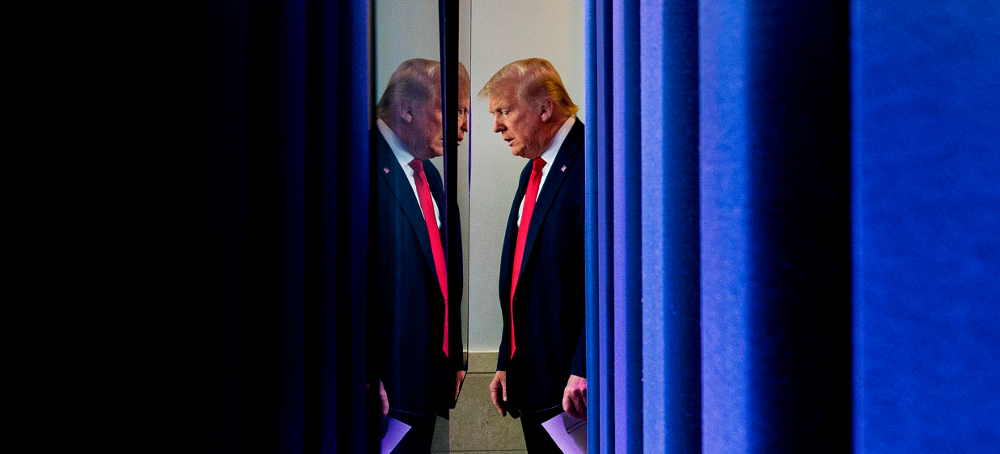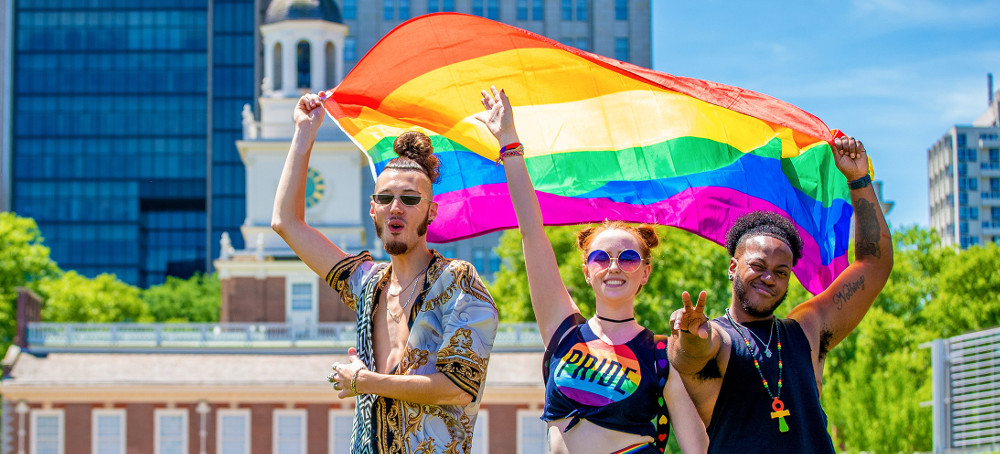Live on the homepage now!
Reader Supported News
None of this has occurred. Trump’s popular base is rock-solid. Roughly two-thirds of the Republican Party want him as their party’s nominee, and just under one-third of the overall electorate intends to vote for him. Swing voters will prove decisive, but polls don’t always tell the story. Enough mainstream voters ((cast their ballots for Trump but, feeling guilty or ashamed, they didn’t inform the pollsters)). No less than with other fascists, establishmentarians greased the wheels for Trump’s victory in 2016, and these “moderate” Republicans remain (afraid of opposing him on any issue of significance ranging from ((his endorsement of white supremacists)) to his false insistence that the 2020 election was stolen to his support for the insurrectionists of January 6, 2021.
Moderate Republican voters, especially in the suburbs, might stay home for the 2024 elections. But the opposite might also occur. They are worried about a jittery economy fueling inflation, skeptical about over-spending in defense of Ukraine, distressed over identity politics, and ready to battle “woke culture.” Moreover, many also harbor a mixture racist anxiety and xenophobic anger against Black Lives Matter and the five million immigrants that have crossed the Southern border since President Joe Biden took office in 2020.
Whether the Democratic party can bring out its base and independent allies is the crucial question, which is complicated by institutional mechanisms benefiting Republicans and media whose ratings soar when they cover Donald Trump. As a party supportive of capitalist elites, Republicans deliberately want to keep the vote-count low ((and, especially at local levels, they have successfully passed micro-legislation that makes voting sites inaccessible, transporting voters to them more difficult, providing them with toilets more complicated, and offering water to those waiting to cast their ballots more cumbersome. ))
Redrawing or re-zoning districts, or what is termed “gerrymandering,” also favors Republicans in 19 states and ((their candidates competing for)) over 40% of congressional seats. ((Such changes also impact the electoral college, an anti-democratic vestige of America’s founding, which can play a decisive role)) in presidential contests. For example: Al Gore, the Democratic Party’s candidate in 2000 won a popular majority by 500,00 ballots, but lost the electoral college by 5 votes to the Republican candidate George Bush, and Hillary Clinton in 2016 received 3 million more votes than Trump, yet lost the electoral college 306 to 232.
However, none of this explains the fervent loyalty that Trump is accorded by his followers. Charisma alone is also ((insufficient for making sense of this.)) The charismatic personality becomes charismatic only insofar as, wittingly or unwittingly, it stands for something. Trump is usually portrayed as self-interested, unprincipled, a charlatan, and a crook—and he is. Yet, the snake-oil salesman’s potion works on his intoxicated audience. Through his bully-pulpit, manipulation of the media, legislative actions, and incitement to violence, the ex-president recast the United States in the image of his followers and, in their eyes, made America great again. That was his accomplishment.
Trump reinvigorated what had become a moribund conservatism when President George Bush left office amid a failed war against terror, a devastating economic depression, and a feeling of ideological drift and depression over the election of President Barack Obama. Intent on re-fighting the American Civil War (1861-1865), and rehabilitating the “lost cause” of the slave-holding Confederacy, Trump’s bile erupted like boiling lava from a volcano. America’s most bigoted and reactionary forces which had seemingly been confined to state and local politics, now overflowed onto the national stage thus legitimizing the cultural vision of a nation dominated by white Christian men and women who are ((ant-secular, anti-science, and anti-intellectual. What Trump calls “patriotic education” has taught them that the United States is the incarnation of freedom and democracy, and they don’t wish to hear anything to the contrary.)) Inspired by dreams of a “gilded age,” when the nation belonged to them, they fear having it taken away by immigrants, people of color, feminists, and the LGBTQ community.
((So far as they are concerned, Trump did what he promised and no civil suit, sex-scandal, indictment, bad press, jail time, or “witch hunt” can change that)) The ex-president’s bombastic worldview now defines the Republican Party. All his serious rivals for its presidential nomination are campaigning within his framework and on his terrain. They are using his issues, his disrespect for truth, his institutional racism, and his pandering to elites. ((They too call for de-regulating the market, “weaponizing” the state, )) and rebelling against the slew of cultural advances inherited from the New Left. ((Trump’s rivals may qualify their proposals a bit, temper their language and style, but their audience is his audience. Those who reject)) his worldview now hover around 2% whereas those who grudgingly identify with it, as ((they tentatively distance themselves from him, appear as “Trump-lite” -- and come up short )) when measured against the real thing.
The ex-president is the overwhelming favorite to win his party’s nomination. The 2016 election will likely repeat itself as Trump’s half-dozen intra-party ((challengers)) split the anti-Trump vote, thus leaving him with a plurality. Money is also flowing into Trump’s coffers from large donors, but also from everyday supporters in $5 and $10 contributions. His people don’t read the New York Times or watch CNN, PBS or NBC,(( and most don’t even bother with FOX, which reaches only a tiny minority of American citizens. Bereft)) of education, uninterested in established media, skeptical of information, contemptuous of the state, and hoping to avoid paying taxes, Trump’s audience ((exists in a no-man’s land)) of rumors about cabals led by George Soros, warnings about the insidious deep-state by Q-Anon, threats to democracy from the New World Order, and neo-Nazi rantings about the “great replacement” of white people by people of color. ((It doesn’t matter to them whether Trump is branded a pathological liar, a degenerate, a criminal, a puppet of business elites, or even a traitor. Clinging to their guns, these self-styled patriots fumble with ideas and information)) in a post-truth society resting on what Herbert Marcuse termed “repressive tolerance.”
Calling for a dialogue with this audience is naïve. Hillary Clinton was right when she called them “deplorables.”(( They are deplorable for their cynicism, their use of the double standard, and their lack of good will. No wonder that Trump has already ))stated his refusal to debate opponents in the primaries. He has little to gain. Should the ex-president campaign from a jail cell, and bewail yet another “stolen” election,(( he might call for violent protests and perhaps even)) another insurrection. Like so many other fascists, he ((could then)) present himself as the savior alone capable of ending the chaos that his troops unleashed.
Trump may lose the battle of 2024, but his troops will remain, standing by and ready, when someday in the future, they can((again mount the barricades.)) Once Trump becomes the presidential candidate of the Republican Party, events can transpire that no one can predict in advance. We saw that in 2016 – and we can only hope not to see it again.
Stephen Eric Bronner is Co-Director of the International Council for Diplomacy and Dialogue (www.icdd.info) and Board of Governors Distinguished Professor Emeritus of Political Science at Rutgers University.
Reader Supported News is the Publication of Origin for this work. Permission to republish is freely granted with credit and a link back to Reader Supported News.
READ MORE Federal prosecutors have obtained audio in which the former president acknowledged he retained a classified paper on Iran. (photo: Jim Watson/AFP)
Federal prosecutors have obtained audio in which the former president acknowledged he retained a classified paper on Iran. (photo: Jim Watson/AFP)
Federal prosecutors have obtained audio in which the former president acknowledged he retained a classified paper on Iran
The document at issue is understood to be classified as “secret” – significant as the justice department typically prefers to charge espionage cases involving retention of materials at that level, rather than “top secret” papers that might be too sensitive or “confidential” papers that are too low.
The recording was made at Trump’s Bedminster golf club in July 2021, when the former president met with people helping his former chief of staff Mark Meadows write a book, by his aide Margo Martin who regularly taped conversations with authors to ensure they accurately recounted his remarks.
For several minutes of the audio recording, the sources said, Trump talks about how he cannot discuss the document because he no longer possesses the sweeping presidential power to declassify now out of office, but suggests that he should have done so when he was still in the White House.
But the previously unreported suggestion that he should have declassified the document presents a potentially perilous moment, as it indicates Trump knew that he had retained material which remained sensitive to national security – as well as the limitations on discussing it with unauthorized people. CNN earlier reported that prosecutors had the recording.
Prosecutors in the office of special counsel Jack Smith appear to have obtained the recording around March, as the criminal investigation targeting Trump intensified and numerous Trump aides were subpoenaed to testify before the federal grand jury hearing evidence in the case in Washington.
The tape was played to multiple witnesses, including Martin, when she testified in mid-March after having her laptop and phones imaged by prosecutors, the sources said. The first time the Trump lawyers learned about the tape was after Martin testified, one of the sources said.
In his book titled A Chief’s Chief, Meadows recounts how Trump once recalled a four-page report produced by the chairman of the joint chiefs of staff Mark Milley that contained his plan to attack Iran, though it is unclear if that was the same meeting attended by his writers.
But the July 2021 meeting that was recorded came shortly after Trump was incensed about news reports that Milley had urged him not to attack Iran in the final weeks of his presidency.
Trump believed that the document outlining the report to attack Iran would undercut Milley’s reported assertions, though the report was actually written earlier in the Trump administration when Joseph Dunford was chairman of the joint chiefs, a person familiar with the document said.
A Trump spokesperson said in a statement: “Leaks from radical partisans behind this political persecution are designed to inflame tensions and continue the media’s harassment of President Trump and his supporters. It’s just more proof that when it comes to President Trump, there are absolutely no depths to which they will not sink as they pursue their witch hunts.”
READ MORE  People participate in the annual Pride Parade in Philadelphia. (photo: J. Fusco/Visit Philadelphia)
People participate in the annual Pride Parade in Philadelphia. (photo: J. Fusco/Visit Philadelphia)
Regressive laws, waning corporate allyship, and threats of violence stoke fear and confusion.
Though LGBTQ people and by extension Pride have won important rights and gained fairly widespread acceptance in US political and social life in recent decades, right-wing politicians, religious leaders, and talking heads are creating a renewed environment of animosity and uneasiness for queer people throughout the country.
In Los Angeles, an ostensibly liberal city with a large LGBTQ community, the Los Angeles Dodgers disinvited — and then re-invited — the Sisters of Perpetual Indulgence to a June 16 event honoring the group for its activism after complaints from conservatives. The SPI is an activist group and nonprofit that accepts members of all identities and backgrounds to raise money for LGBTQ causes. In Florida, the cities of Port St. Lucie and St. Cloud canceled Pride events due to uneasiness and fear in the wake of anti-LGBTQ bills signed by Florida Gov. Ron DeSantis. In Fayetteville, Arkansas’ queer mecca, Northwest Arkansas Equality canceled events at the Walton Arts Center due to its ban on drag performances in front of minors.
The status of multiple Tennessee pride events was uncertain after that state passed a vaguely-worded bill— widely understood to be targeting drag performances — limiting “adult cabaret” shows in March. Events in both Knoxville and Murfreesboro seemed to be on track despite earlier concerns. Organizers of both events did not respond to Vox’s request for comment by press time. And previous reports of Tampa’s Pride festivities being canceled may actually have more to do with the management and finances of the group running those events than a climate of fear in Florida, according to reporting from Axios.
Regardless, the number of anti-LGBTQ laws passed over the last year combined with growing anti-LGBTQ antagonism and very real threats of violence mark an alarming shift away from equality and inclusion.
The legislation of hate and threats to safety from extremist groups
In the past year, several states have passed bills targeting medical care for trans youth, teaching LGBTQ history or discussing queer sexuality in public schools, and restricting drag performances, causing confusion and fear for queer people throughout the country.
Florida and Arkansas have both passed laws targeting LGBTQ people, including prohibitions on discussing gender and sexuality for certain age groups in public schools. Florida’s legislation made headlines as the “Don’t Say Gay” bill and was recently expanded to prohibit discussion of LGBTQ sexuality in all grades, not just through third grade. Florida, like Tennesee, has passed a bill limiting drag performances, though restaurant chain Hamburger Mary’s is suing the state to block the law, saying it infringes on the First Amendment.
Arkansas Gov. Sarah Huckabee Sanders also jumped on the anti-drag bandwagon shortly after she started her tenure in January, endorsing legislation to classify drag as “adult-oriented performance.” “I think we have to do everything — I’ve been very clear and talked about this pretty extensively — to protect children,” Sanders said in a January interview with the Arkansas Democrat-Gazette. “I think that’s what this bill does.”
Furor over drag performances — and the fear that such expression will somehow harm children — seems to have originated with drag story hours held at libraries across the country since 2015. Even in New York City, where the nonprofit Drag Story Hour is located and which has long been a nexus of queer activism, performance, and acceptance, protesters recently disrupted a story hour event hosted by New York Attorney General Letitia James, just blocks away from the Stonewall Inn.
The theme of “protecting children” runs through anti-LGBTQ legislation and rhetoric, as Vox’s Nicole Narea and Fabiola Cineas reported in April.
It’s become a means of proving conservative bona fides to GOP primary voters, including right-wing evangelicals, and it’s coming from the top down: Former President Trump announced earlier this year that, if reelected, he would “stop” gender-affirming care for minors, which he said was “child abuse” and “child sexual mutilation.” He also said he would bar federal agencies from working to “promote the concept of sex and gender transition at any age.”
As Narea and Cineas point out, several states have already approved anti-trans legislation. DeSantis earlier this month signed a bill prohibiting gender-affirming medical care for trans youth, and Sanders signed a bill in March making it easier to file a malpractice suit against medical providers giving gender-affirming care to trans kids. That’s in addition to a law already on the books banning hormone treatment, gender-affirming surgery, or hormone blockers for trans youth, which is currently being held up in court. Idaho, Indiana, Kansas, Missouri, Texas, Oklahoma, and Alabama are among the states seeking to limit care for trans youth or restrict trans people’s ability to participate meaningfully in society, whether that’s through so-called bathroom bills, bans on trans athletes, or making it difficult for people to change their sex on official documents.
There’s also the very real possibility of violence against queer people this Pride; as Insider reporter earlier this month, the extremist group the Proud Boys has pledged to hold its largest-ever anti-LGBTQ “Proud” events this year. The “Western chauvinist” group has interrupted and protested at drag story hours in the past, and although their specific plans reported by Insider haven’t thus far included plans for violence, the group is known for inciting chaos and fighting at its events.
“I don’t see how we don’t end up having more violence next month,” Heidi Bierich, co-founder of the Global Project Against Hate and Extremism, told Insider. “It’s frankly getting a little out of control.”
Anti-LGBTQ sentiment evokes Pride’s roots in activism
The present milieu has set back progress for queer people all over the country, not just in states that have passed anti-LGBTQ legislation. Violence against queer people — whether that’s via legislation, social exclusion, or outright brutality — has never stopped in the US. As LGBTQ people won rights and recognition through collective action and protest, such violence became less socially acceptable.
But as the right has leveraged anti-LGBTQ backlash as an electoral strategy, the risk that queer people will be even more of a target for violence than they already are increases.
The concept of stochastic terror — that violent rhetoric and communication by influential people allow their followers to see violence as a viable political tactic, even without explicit instruction, thereby increasing the chances that at least some people will commit targeted violence — echoes Bierich’s concerns leading up to Pride month.
The risk has already borne out in recent months; in November, a man entered Colorado Springs’ Club Q and opened fire, killing five people and wounding 17 at a drag queen’s birthday party. He has since been charged with hate crimes.
On a consumer level, institutions like Target, Anheuser-Busch, and the Dodgers have responded to criticism and threats from conservatives by walking back pro-LGBTQ products and statements, rather than standing in solidarity with a marginalized community. Target said its employees faced harassment over Pride merchandise, specifically a “tuck-friendly” swimsuit intended for trans adults, thus its decision to pull some products from its shelves.
The anti-LGBTQ atmosphere brings into focus the real history of Pride — as a celebration, but also as a protest. Though politicians, celebrities, and corporations have adopted the rhetoric of allyship in recent years, acceptance and visibility blunted the necessity of activism. AIDS is no longer a death sentence with proper treatment, and gay marriage is the law of the land. RuPaul’s Drag Race has found international success, and huge corporations sponsor floats at Pride parades in major cities; socially and politically, queer people have largely become part of the fabric of American life.
But despite massive progress in the decades since Pride officially started in 1970, life for many queer people in the US is still dangerous and difficult. The high rates of homicide, violence, and harassment against trans people, and particularly trans people of color is just one critical issue facing the LGBTQ community; with the proliferation of anti-LGBTQ legislation and the right’s ability to stoke anti-LGBTQ sentiment for political gain, the threat to the queer community increases.
READ MORE  Security forces affiliated with Russia and the Central African Republic around the party headquarters of current President Faustin Archange Touadera. (photo: Nacer Talel/Anadolu Agency)
Security forces affiliated with Russia and the Central African Republic around the party headquarters of current President Faustin Archange Touadera. (photo: Nacer Talel/Anadolu Agency)
“I asked everyone for help ... was I supposed to refuse the help from those who wanted to help us?” Central African Republic President Faustin-Archange Touadéra tells NBC News.
It was 2016, soon after his election, and rebels had overrun swaths of the resource-rich country, which is among the world’s poorest nations. Former colonial power France announced it would withdraw its soldiers, the backbone of a United Nations force aimed at quelling the country’s civil war.
And Touadéra’s army and militia didn’t have enough weapons to defeat fighters threatening the capital, Bangui, because the Central African Republic was under a U.N. arms embargo put in place after a previous rebel takeover.
So the former mathematics professor turned to Moscow.
While Russia received approval from the U.N. Security Council to deploy military trainers to assist the central African country’s government, Moscow sent in the infamous Wagner Group.
“I couldn’t sit idly by. I asked all my friends, including in the United States, including France,” Touadéra, 66, said during an exclusive interview with NBC News last week.
“I need to protect the population. I need to protect the institutions of the republic. I asked everyone for help, and was I supposed to refuse the help from those who wanted to help us?” he added.
But Wagner’s help isn’t free.
In exchange for its work, the group has gained direct access to the Central African Republic’s natural resources, according to Sorcha MacLeod, a member of the U.N. working group on the use of mercenaries.
“We received information in Central African Republic that the Wagner group was being paid in mining concessions,” she said.
Trading in natural resources gives Wagner, and Russia, a way to evade sanctions put in place since the start of the war in Ukraine last February.
And now, despite Wagner sending tens of thousands of fighters to the war in Ukraine, many of them former prisoners, there’s been no exodus of the group from Africa. Instead there’s been a “doubling-down of Wagner’s presence” and an expansion into other countries, MacLeod said.
The mercenary group is operating in a volatile environment. The Central African Republic has suffered from a series of coups and failed governments since gaining independence from France in 1960. The latest coup in 2013, which saw Christian and Muslim militias pitted against each other, was organized by Séléka, a coalition of rebel groups.
A U.N. peacekeeping mission has not stamped out the violence and, in fact, hundreds of its soldiers have been sent home after reports of sexual abuse.
Mines and mercenaries
Wherever Wagner has gone, accusations of widespread and unchecked human rights abuses have followed, including executions, rapes and torture.
While Touadéra never used the word Wagner, Sewa Security Services and the Officers Union for International Security both operate in the Central African Republic on behalf of the mercenary group, according to the U.S. Treasury Department, which has sanctioned them.
Before the interview with Touadéra, an NBC News crew saw two of the top Wagner representatives in the country, Vitaly Perfilev and Dmitry Sytii, escorting a Russian television crew in the president’s offices. Perfilev has been sanctioned by the European Union for being “responsible for serious human rights abuses” while working for Wagner in the country.
NBC News, working with the U.S.-based investigations and advocacy group The Sentry, has looked into Wagner’s role in taking control of the Ndassima gold mine in the center of the nation, and developing the site into a large-scale operation with the potential to net the group hundreds of millions of dollars in profits.
Officially, the Russian “instructors” were on a mission to clear rebels from the area in 2021. However, witnesses and official reports accuse the group of targeting civilians, some of whom had been engaging in small-scale or “artisanal” mining in the area.
According to the Sentry, Wagner violently seized control of Ndassima.
A 25-year-old woman, whose name is being withheld for her protection, said her husband had been working at the mine when he was ordered out by Russian fighters in the fall of 2021.
“When they came, they presented documents saying that it was the government of our country that gave them permission and that this territory now belongs to them,” she said. “They didn’t say with their own mouths that they were Russians, but we knew they were Russians.”
After her husband refused to leave and abandon his work at the mine, she said, he was shot to death along with seven colleagues.
“They came for our wealth, for our gold,” she said. “They’ve already started killing our husbands because of our own country’s wealth.”
NBC News could not independently verify the specific account, and traveling to the areas around the mines can be dangerous. In 2018, three Russian journalists were killed in the Central African Republic while investigating Wagner, the team’s editor at Investigation Control Centre was quoted by saying. (The news group, backed by leading anti-Putin activist Mikhail Khodorkovsky, closed down after the journalists’ deaths.)
U.S. sanctions designation also says Wagner denies access to Central African Republic government officials to visit mining sites controlled by the mercenary group.
But a U.N. report in February states that killings and disappearances continued to be carried out in Ndassima even after the rebels were removed.
No known Wagner entity has acknowledged ownership of the mine, but four senior Western diplomats said the Ndassima mine was wholly controlled by the mercenary group. (The diplomats spoke on the condition of anonymity because they are not authorized to speak openly on the subject.)
Meanwhile, some fighters who carried out attacks on civilians say they were under direct orders to clear the areas in so-called “cleansing operations.”
One former member of a pro-government group working with Wagner told the Sentry that he was initially recruited to go on missions against the Séléka coalition.
But soon they were targeting the civilian population, he said.
“We massacred a lot of civilians,” he said. “That bothers me a lot. The Russians gave the orders, they say it’s mandatory. There were a lot of executions in the mining sites with the Russians, we killed the workers, we recovered the (mining) products.”
Civilian victims say the attacks went far beyond targeting armed rebels, but were aimed at terrorizing the community and looting gold from workers and traders.
“Many young people have been abducted, raped and murdered … even I too was raped by two Russians,” one mine worker told the Sentry.
These allegations, which NBC News has not verified, align with accusations made by U.S. officials, who have classified Wagner a transnational criminal organization for engaging in “serious criminal activity, including mass executions, rape, child abductions, and physical abuse in the Central African Republic (CAR) and Mali.”
‘Extractive, brutal, destructive’
Wagner’s influence extends throughout the continent, according to Sen. Chris Coons, D-Del.
“They’re an extractive, brutal, destructive influence” in African countries, said Coons, a member of the Senate Foreign Relations Committee and a prominent voice on Africa in Congress.
Wagner is often brought in to help African governments with insurgencies, particularly in countries where an elected government has been overthrown in a coup and the U.S. is no longer a security partner, he said.
But the outfit has proven to be “unreliable” and “unsuccessful” in countering terrorism, and more focused on serving its own ends “to extract as much as they can in terms of money and mineral resources,” Coons said.
In the past several years, Wagner has become “a predatory mercenary force” in impoverished, unstable countries in Africa, including the Central African Republic and Mali, he added.
Asked to respond to reports of atrocities carried out by Russian fighters in Ndassima, presidential adviser Fidéle Gouandjika said in an interview at his home in Bangui that Russian soldiers conducted security operations around the mine and sites to clear rebel groups. He denied reports of atrocities.
“They don’t steal, they don’t kill people,” he said.
A 2021 memo from the Central African Republic’s minister of mines to the president, obtained by the Sentry and reviewed by NBC News, announced that a Russian company was taking control of Ndassima, and that Moscow’s contributions to national security should be taken into consideration.
However, there is no official registration for the company in the country.
Satellite imagery of the site shows that since 2021, when the rebels were cleared and the alleged atrocities took place, the mine has been rapidly developed, with expanded mining pits, digging machines and a large processing facility.
A feasibility study commissioned by Axmin, a Canadian company that previously owned the mine, states that the total production of the entire site could produce about 45 tons of gold over eight years, which would be worth more than $2 billion at today’s prices.
Hans Merket, an analyst at International Peace Information Service, an independent research institute in Belgium, said the processing plant is “state of the art” but notes that it is not yet operating nearly at full capacity.
Given the costs of operating in such a difficult environment, the mine could realistically generate more than $100 million a year, he said, adding that this is clearly a long-term investment.
“You wouldn’t set up this sophisticated processing facility to just work in a short term in a small area, this is a plan to do something larger,” Merket said.
Wagner chief Yevgeny Prigozhin declined to provide more details about the group’s operations in the Central African Republic, including the use of Ndassima.
“I think you’ve received enough information about the activities of PMC “Wagner” in Africa from those you’ve already spoken with,” he said in a voice message sent as an attachment in an email. “As for other questions, we will discuss this topic when you start to present them properly and not ask them in a provocative manner.”
He added: “If by asking these questions, you intended just to run up and spit at me, then I suggest that you come closer. And after that, try and figure out if it’s your throat in my hands, or someone else’s.”
READ MORE The exterior of Allina Health United Hospital in St. Paul, Minnesota. (photo: Tim Gruber/The New York Times)
The exterior of Allina Health United Hospital in St. Paul, Minnesota. (photo: Tim Gruber/The New York Times)
Doctors at the Allina Health System, a wealthy nonprofit in the Midwest, aren’t allowed to see poor patients or children with too many unpaid medical bills.
But a wealthy nonprofit health system in the Midwest is among those taking things a step further: withholding care from patients who have unpaid medical bills.
Allina Health System, which runs more than 100 hospitals and clinics in Minnesota and Wisconsin and brings in $4 billion a year in revenue, sometimes rejects patients who are deep in debt, according to internal documents and interviews with doctors, nurses and patients.
READ MORE  Headstones and American flags are seen at the Arlington National Cemetery during the Memorial Day, which is held annually to honor those who died while serving in the armed forces. (photo: Anadolu Agency)
Headstones and American flags are seen at the Arlington National Cemetery during the Memorial Day, which is held annually to honor those who died while serving in the armed forces. (photo: Anadolu Agency)
Non-combatants bear the brunt of the toll of modern war, but we don’t know how to memorialize them.
It wasn’t long, though, before remembrance began to be overshadowed by celebration. Within a year, the New York Times opined the holiday would no longer be “sacred” if parades and speeches became more central than the act of memorializing the dead. Which is precisely what happened, especially after Congress in 1971 fixed Memorial Day as the last Monday in May, making it the perfect launchpad for summer, with an increasingly perfunctory nod to the holiday’s original purpose.
The gap between those for whom Memorial Day is a moment of remembrance versus three days of hot dogs and hamburgers will likely only grow in the future, as veterans of previous wars pass away and the divide between America’s all-volunteer military and its civilians deepens. Fewer than 1 percent of the US adult population serves in the military, and those still signing up increasingly come from a small handful of regions and families with a history of military service. (You can include my own family in that ever rarer number: My brother is a retired Army captain who served in Iraq.)
With an ever-inflating defense budget — now north of $800 billion — the footprint of the US military is hardly shrinking, but the number of those who will potentially be called on to give what Lincoln called the “last full measure of devotion” is.
Yet there’s a greater gap embedded in Memorial Day: It’s between those who died as warfighters (to use one of the Pentagon’s terms), and the far greater number around the world who have died as war’s victims.
When civilians die in war
The past is not just a foreign country to us, but a bloody one. From the interpersonal to the international, conflict was a constant throughout much of human history. Between 1500 and 1800, there was hardly a year when great powers weren’t enmeshed in some kind of war.
Though war became somewhat less common as we entered the 1900s, it did not become less deadly. Far from it — while the death toll of war in the past was more chiefly concentrated among combatants, the 20th century saw the awful blossoming of total war, where little to no distinction was made between those fighting the war and the civilians on the sidelines, and new weapons enabled mass, indiscriminate killing.
Go back to the Civil War, which sits at the junction between battle as it had long been practiced and the greater horror it would become. Over 600,000 soldiers were killed in the conflict, against at least 50,000 civilians, ranging from those killed directly to the many who died in the wake of war, from starvation and disease.
That number was terrible, yet in the wars to come, it would only grow.
In the First World War, a roughly equal number of combatants and civilians were killed globally — approximately 10 million on each side. In the Second World War, more combatants were killed than in any other conflict in human history, a toll nearing 15 million. Yet for every soldier, sailor, or airman who was killed, nearly one and a half civilians would die, totaling, by one count, almost 40 million.
The last of the dead would come in Hiroshima and Nagasaki, when as many as 210,000 people — nearly all of them Japanese civilians — died in the first and so far only atomic bombings. Not only were these new weapons capable of murdering at a vastly larger scale than ever before, but they existed chiefly to threaten the lives of noncombatants.
Thankfully, given the weapons militaries now had at their disposal, World War II was the high mark for war deaths. In the decades that followed, deaths in battle for both combatants and civilians sharply declined, minus the occasional spike in conflicts like the Korean and Vietnam Wars. People around the world today are far, far less likely to die in war than their ancestors, which is one of the most undeniable — if tenuous — markers of our species’ under-appreciated progress.
Yet even in this era of comparative peace, civilians still bear the brunt of war when it comes, including when it is fought by the United States. According to Brown University’s Costs of War project, more civilians were likely directly killed in post-9/11 conflicts than fighters on either side — and when the number of indirect deaths from starvation and destruction are included, that gulf only widens.
In Ukraine, according to one source, more than twice as many Ukrainian civilians as soldiers have been killed in the war. On the morning after Memorial Day, Ukrainian drones struck civilian areas of Moscow, on the heels of yet another Russian bombardment of Kyiv. “These attacks are very exhausting because we do not sleep at night,” one 32-year-old Ukrainian mother of two told the New York Times. “Even if I fall asleep, I have nightmares.”
A new kind of Memorial Day
The US has its Memorial Day to honor fallen soldiers, while other countries have their Remembrance Day, their Victory Day. Yet there are only a handful of monuments to honor the countlessly greater number of civilians killed in war.
It’s not hard to imagine why. As the shift in perception around the Vietnam Veterans Memorial has shown — from unpatriotic atrocity to a celebrated work of national mourning — we can honor the sacrifice of service members who died in a war, even if we don’t believe in the war. But the death of those who died without a rifle in hand, who died in childhood and infancy, who died because they could not fight and could not be protected, shows war for what it ultimately is: a waste. And we can’t begin to know how to mark the unmarked.
America has been a historical exception in many ways, but perhaps no more so than that its civilian citizens have largely escaped the scourge of war. (Though the same, of course, can hardly be said for its Indigenous populations, so long treated as enemy combatants in their own land.) Americans have fought and Americans have died, but at an ever-increasing remove, a distance that grows with each Memorial Day.
The general decline of war is one of our great accomplishments as humans, something to be unequivocally celebrated. Perhaps we would feel that more if we gave the deaths of civilians the same honor as that of soldiers — a new kind of Memorial Day that can begin here.
READ MORE  Clifford Walters, a Hawaii man, pleaded guilty to disturbing wildlife after he tried to help a stranded bison calf reunite with its herd. (photo: Hellen Jack/National Park Service)
Clifford Walters, a Hawaii man, pleaded guilty to disturbing wildlife after he tried to help a stranded bison calf reunite with its herd. (photo: Hellen Jack/National Park Service)
Clifford Walters, a Hawaii resident, was charged with "one count of feeding, touching, teasing, frightening, or intentionally disturbing wildlife," according to a statement from the U.S. Attorney's Office for the District of Wyoming.
Walters paid over $1,000 in fines, including a $500 community service payment to Yellowstone's wildlife protection fund, the attorney's office said.
According to an initial report from the National Park Service, the newborn bison had been separated from its mother on May 20 as its herd was crossing the Lamar River.
Walters, observing the scene, tried to help the calf by pushing it up the bank, into the roadway, NPS said.
Park rangers repeatedly tried to reunite the calf with the herd, but the herd resisted, which is common when humans interfere with wildlife, NPS said.
The calf was later euthanized by park staff because it was "causing a hazardous situation by approaching cars and people along the roadway," according to a press release.
In reviewing the report, the attorney's office said there was nothing to suggest Walters "acted maliciously."
NPR made several attempts to contact Walters for comment but could not confirm reliable contact information for him.
Why did Yellowstone have to euthanize the calf?
As the initial news of the calf's death broke last week, thousands of NPR readers responded on social media with concern, frustration and confusion. Many wanted to know: Did park rangers really need to euthanize the animal?
In a follow-up statement, NPS firmly defended its decision, saying that it made the choice "not because we are lazy, uncaring, or inexpert in our understanding of bison biology" but because "national parks preserve natural processes."
Even before news of the calf started gaining traction online, Yellowstone was clear on its policy of not rescuing and rehabilitating animals. It lists only a handful of situations in which it might intervene, including if Congress directs it to or if the long-term health of an ecosystem is at risk.
The fate of a sole bison calf — one of roughly 5,900 bison in the park — falls outside of that list.
"In fact, as many as 25% of the bison calves born this spring will die, but those deaths will benefit other animals by feeding everything from bears and wolves to birds and insects," NPS said in its second statement.
"Unfortunately, the calf's behavior on roads and around people was hazardous, so rangers had to intervene: but the calf's body was left on the landscape," the agency added.
Why couldn't the park bring the calf to an animal sanctuary?
NPS also pointed out that it's illegal to transport bison out of Yellowstone "unless those bison are going to meat processing or scientific research facilities."
The states of Montana, and, to a lesser extent, Wyoming, limit the transport of live bison in order to protect local livestock. Mass migrations of the species could damage local property, compete for local food supplies and spread brucellosis, a bacterial disease that only marginally affects bison but causes infertility and low milk production in domestic cows.
Brucellosis cases spiked in the U.S. in the mid-1900s, causing the U.S. Animal and Plant Inspection Service to implement nationwide livestock testing and vaccination requirements.
Today, the spread of brucellosis among Yellowstone's free-ranging bison is one of the issues monitored by the Interagency Bison Management Plan, a cooperative of eight groups, including federal agencies and tribal nations.
That group has agreed to start transferring some live bison to tribal nations as a way to restore herds outside of Yellowstone and manage the size of the park's own healthy herd. But any transferred bison have to first be quarantined and tested for brucellosis.
The testing process can be lengthy and expensive. (It took 17 months for the first transferred group to be tested in 2019 — and that was on top of eight years of working out the legal logistics to make it happen, NPS said.) In the end, only about 30% of animals qualify for the program.
"A newborn calf that's abandoned and unable to care for itself is not a good candidate for quarantine," the park said last week.
For anyone still looking for a good takeaway about preventing another unfortunate animal death, Yellowstone wants to underscore this one: "Give animals room to roam."
Follow us on facebook and twitter!
PO Box 2043 / Citrus Heights, CA 95611



No comments:
Post a Comment
Note: Only a member of this blog may post a comment.